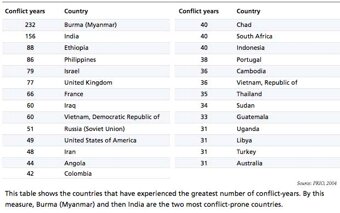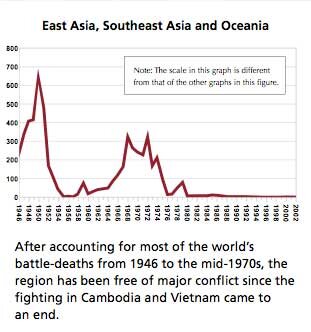
AsiaPundit is a loyal reader of the Economist, as are Will at Imagethief and Younghusband at Coming Anarchy, and he experiences near withdrawal when the magazine newspaper takes its annual Christmas/New Year’s publication break.
Thankfully, they always produce a brilliant double-sized feature-filled Christmas issue to tide loyal subscribers over. In this year’s edition, the Economist has provided several excellent features of interest on Asia.
First, a study of the sex toy industry in China.:
The Communist Party grudgingly opened its doors to private entrepreneurs only three years ago. But it remains uneasy about the age-old practice of keeping businesses under patriarchal control and handing them down through the male line.
And it is just as uneasy about sex, although the visitor to the Wu showroom in Wenzhou, run by the 36-year-old eldest son, Wu Wei, might not believe it. Mr Wu pauses only briefly in the first section, adorned with reproductions of antique Chinese paintings of copulating couples. He points to one showing women in classical attire buying dildos from a street merchant. “Look, they used them in those days”, he says, as if to justify with historical precedent what comes next.
Mr Wu ushers the visitor into the main exhibition: row upon row of sex toys in a rainbow array of rubber, plastic, leather and—he proudly asks your correspondent to squeeze this one—a sponge-like material designed to simulate the texture of female flesh. Hung on one wall is a macabre line of near life-size inflatable dolls, their rouged mouths agape as if in horror at the implements before them: the Vertical Double Dong, the Occidental Vagina, the Waterproof Warhead Vibe (“Bathtime was never this fun”) and a variety of black leather and metal goods for fans of sadism and masochism (for overseas markets, that is; the Wus see S&M potential in China too, but party cadres do not).
To follow, a feature on the increasing humanization of robots in Japan:
 HER name is MARIE, and her impressive set of skills comes in handy in a nursing home. MARIE can walk around under her own power. She can distinguish among similar-looking objects, such as different bottles of medicine, and has a delicate enough touch to work with frail patients. MARIE can interpret a range of facial expressions and gestures, and respond in ways that suggest compassion. Although her language skills are not ideal, she can recognise speech and respond clearly. Above all, she is inexpensive . Unfortunately for MARIE, however, she has one glaring trait that makes it hard for Japanese patients to accept her: she is a flesh-and-blood human being from the Philippines. If only she were a robot instead.
HER name is MARIE, and her impressive set of skills comes in handy in a nursing home. MARIE can walk around under her own power. She can distinguish among similar-looking objects, such as different bottles of medicine, and has a delicate enough touch to work with frail patients. MARIE can interpret a range of facial expressions and gestures, and respond in ways that suggest compassion. Although her language skills are not ideal, she can recognise speech and respond clearly. Above all, she is inexpensive . Unfortunately for MARIE, however, she has one glaring trait that makes it hard for Japanese patients to accept her: she is a flesh-and-blood human being from the Philippines. If only she were a robot instead.
Robots, you see, are wonderful creatures, as many a Japanese will tell you. They are getting more adept all the time, and before too long will be able to do cheaply and easily many tasks that human workers do now. They will care for the sick, collect the rubbish, guard homes and offices, and give directions on the street.
As well as the above, the issue features a fine report on Tibetans in exile and their concerns about the eventual passing of the Dali Lama.:
The fear that the Dalai Lama’s death will be a disaster for the Tibetan cause looks justified. His fame as a Nobel-prize-winning guru and friend of the stars has produced little concrete benefit: no government recognises his. But top politicians as well as private citizens are drawn to him. Because of him, Tibet is sand in the wheels of China’s drive to become a respected international citizen. And, under him, India has given Tibetans a home big enough to encompass the dream of cultural survival.
Do you think AsiaPundit is smarter than everyone else because he reads The Economist, or does AsiaPundit read The Economist because he is smarter than everyone else? Now, there’s a conundrum!
(UPDATE: All of that plus World in 2006 podcasts: Amartya Sen on India’s rising star, editor Bill Emmott on Koizumi’s legacy, China correspondent James Miles on the country’s leadership and more. (via World Bank PSD Blog)
Technorati Tags: asia, china, east asia, india, japan, northeast asia, tibet, south asia


 #2
#2 







 HER name is MARIE, and her impressive set of skills comes in handy in a nursing home. MARIE can walk around under her own power. She can distinguish among similar-looking objects, such as different bottles of medicine, and has a delicate enough touch to work with frail patients. MARIE can interpret a range of facial expressions and gestures, and respond in ways that suggest compassion. Although her language skills are not ideal, she can recognise speech and respond clearly. Above all, she is inexpensive . Unfortunately for MARIE, however, she has one glaring trait that makes it hard for Japanese patients to accept her: she is a flesh-and-blood human being from the Philippines. If only she were a robot instead.
HER name is MARIE, and her impressive set of skills comes in handy in a nursing home. MARIE can walk around under her own power. She can distinguish among similar-looking objects, such as different bottles of medicine, and has a delicate enough touch to work with frail patients. MARIE can interpret a range of facial expressions and gestures, and respond in ways that suggest compassion. Although her language skills are not ideal, she can recognise speech and respond clearly. Above all, she is inexpensive . Unfortunately for MARIE, however, she has one glaring trait that makes it hard for Japanese patients to accept her: she is a flesh-and-blood human being from the Philippines. If only she were a robot instead.

 NEW DELHI: Last week 11 MPs had to wrestle with Duryodhan. Now six others have been trapped in a Chakravyuh.
NEW DELHI: Last week 11 MPs had to wrestle with Duryodhan. Now six others have been trapped in a Chakravyuh. To maintain its global share of 65 percent in information technology and 46 percent in business-process outsourcing, the country will need 2.3 million professionals by 2010. According to McKinsey’s calculations, India may face a deficit of as many as 500,000 workers. As much as 70 percent of the shortage will crop up in call centers and other back-office businesses, where proficiency in English is the No. 1 prerequisite for landing a job.
To maintain its global share of 65 percent in information technology and 46 percent in business-process outsourcing, the country will need 2.3 million professionals by 2010. According to McKinsey’s calculations, India may face a deficit of as many as 500,000 workers. As much as 70 percent of the shortage will crop up in call centers and other back-office businesses, where proficiency in English is the No. 1 prerequisite for landing a job. What the F%ck?? As Ennis blurted out loudly in our North Dakota HQ earlier this morning, “Sweet! We’re famous! Dude(ette) - this is so much cooler than I thought the blog would ever get.”….
What the F%ck?? As Ennis blurted out loudly in our North Dakota HQ earlier this morning, “Sweet! We’re famous! Dude(ette) - this is so much cooler than I thought the blog would ever get.”…. States such as Punjab, Haryana, Himachal Pradesh, Chandigarh and Delhi now have fewer than 900 girls per 1,000 boys.” He explains:
States such as Punjab, Haryana, Himachal Pradesh, Chandigarh and Delhi now have fewer than 900 girls per 1,000 boys.” He explains:
 This seems to be a classic case of neighbour’s envy. Muslim clerics in Pakistan are miffed over its government’s recent decision which denies entry to foreign students coming to Pakistan’s seminaries, better known as madrasas, for training. What has particularly irked the clerics is that these students are now looking across the border and enrolling themselves in Indian madrasas for their religious training.
This seems to be a classic case of neighbour’s envy. Muslim clerics in Pakistan are miffed over its government’s recent decision which denies entry to foreign students coming to Pakistan’s seminaries, better known as madrasas, for training. What has particularly irked the clerics is that these students are now looking across the border and enrolling themselves in Indian madrasas for their religious training.


 The Chinese have taken over Diwali well and truly. Houses all over Mumbai have Chinese lights in their balconies ( a very Bombay thing to hang glittering lights in balconies during Diwali). Dirt cheap and almost use and throw (you wont meet anyone who has had these lights for 3 years). They are cheap LEDs, I think and in any case quite unlike the bulbs we owned in our house for 15 odd years when each Diwali meant a few trips to the electrician apart from some of our own pottering with testers and wires.
The Chinese have taken over Diwali well and truly. Houses all over Mumbai have Chinese lights in their balconies ( a very Bombay thing to hang glittering lights in balconies during Diwali). Dirt cheap and almost use and throw (you wont meet anyone who has had these lights for 3 years). They are cheap LEDs, I think and in any case quite unlike the bulbs we owned in our house for 15 odd years when each Diwali meant a few trips to the electrician apart from some of our own pottering with testers and wires. When first graders are going to canvas their ‘hoods for charity, when
When first graders are going to canvas their ‘hoods for charity, when  In a significant announcement, China’s top envoy has declared that his country is ready to help India to crush its nagging Maoist insurgency that it once actively supported.
In a significant announcement, China’s top envoy has declared that his country is ready to help India to crush its nagging Maoist insurgency that it once actively supported.


































